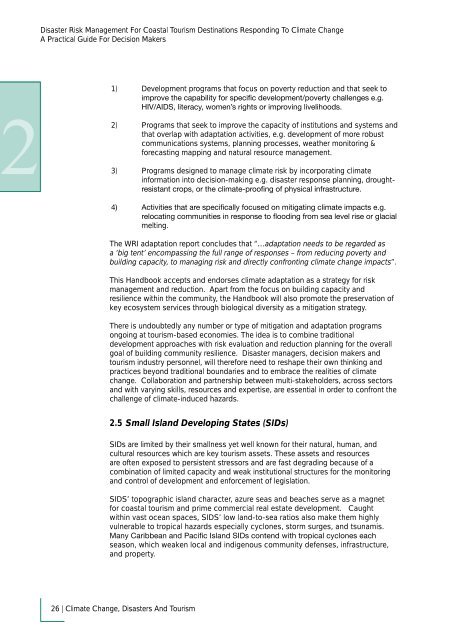Disaster Risk Management For Coastal Tourism Destinations - DTIE
Disaster Risk Management For Coastal Tourism Destinations - DTIE
Disaster Risk Management For Coastal Tourism Destinations - DTIE
You also want an ePaper? Increase the reach of your titles
YUMPU automatically turns print PDFs into web optimized ePapers that Google loves.
<strong>Disaster</strong> <strong>Risk</strong> <strong>Management</strong> <strong>For</strong> <strong>Coastal</strong> <strong>Tourism</strong> <strong>Destinations</strong> Responding To Climate Change<br />
A Practical Guide <strong>For</strong> Decision Makers<br />
1) Development programs that focus on poverty reduction and that seek to<br />
<br />
<br />
2) Programs that seek to improve the capacity of institutions and systems and<br />
that overlap with adaptation activities, e.g. development of more robust<br />
communications systems, planning processes, weather monitoring &<br />
forecasting mapping and natural resource management.<br />
3) Programs designed to manage climate risk by incorporating climate<br />
information into decision-making e.g. disaster response planning, drought-<br />
<br />
<br />
<br />
<br />
melting.<br />
The WRI adaptation report concludes that “…adaptation needs to be regarded as<br />
a ‘big tent’ encompassing the full range of responses – from reducing poverty and<br />
building capacity, to managing risk and directly confronting climate change impacts”.<br />
This Handbook accepts and endorses climate adaptation as a strategy for risk<br />
management and reduction. Apart from the focus on building capacity and<br />
resilience within the community, the Handbook will also promote the preservation of<br />
key ecosystem services through biological diversity as a mitigation strategy.<br />
There is undoubtedly any number or type of mitigation and adaptation programs<br />
ongoing at tourism-based economies. The idea is to combine traditional<br />
development approaches with risk evaluation and reduction planning for the overall<br />
goal of building community resilience. <strong>Disaster</strong> managers, decision makers and<br />
tourism industry personnel, will therefore need to reshape their own thinking and<br />
practices beyond traditional boundaries and to embrace the realities of climate<br />
change. Collaboration and partnership between multi-stakeholders, across sectors<br />
and with varying skills, resources and expertise, are essential in order to confront the<br />
challenge of climate-induced hazards.<br />
2.5<br />
Small Island Developing States (SIDs)<br />
SIDs are limited by their smallness yet well known for their natural, human, and<br />
cultural resources which are key tourism assets. These assets and resources<br />
are often exposed to persistent stressors and are fast degrading because of a<br />
combination of limited capacity and weak institutional structures for the monitoring<br />
and control of development and enforcement of legislation.<br />
SIDS’ topographic island character, azure seas and beaches serve as a magnet<br />
for coastal tourism and prime commercial real estate development. Caught<br />
within vast ocean spaces, SIDS’ low land-to-sea ratios also make them highly<br />
vulnerable to tropical hazards especially cyclones, storm surges, and tsunamis.<br />
<br />
season, which weaken local and indigenous community defenses, infrastructure,<br />
and property.<br />
26 | Climate Change, <strong>Disaster</strong>s And <strong>Tourism</strong>

















